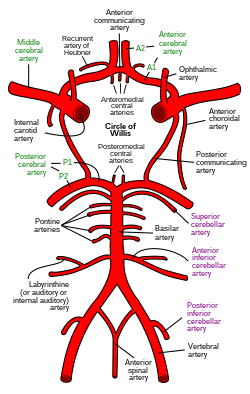| Anterior choroidal artery | |
|---|---|
 Diagram of the arterial circulation at the base of the brain (inferior view). The anterior choroidal artery is labeled at right of the circle of Willis. | |
| Details | |
| Source | Internal carotid artery |
| Identifiers | |
| Latin | arteria choroidea anterior |
| TA98 | A12.2.06.019 |
| TA2 | 4501 |
| FMA | 50087 |
| Anatomical terminology | |
The anterior choroidal artery is a bilaterally paired artery of the brain. It is typically a branch of the internal carotid artery which supplies the choroid plexus of lateral ventricle and third ventricle as well as numerous structures of the brain.
Contents
Occlusion of the artery can result in loss of sensation, loss of part of the visual field, and impaired movement, all on the opposite side of the body as the occlusion.